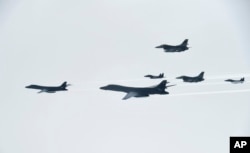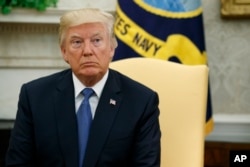As U.S. President Donald Trump pondered possible military strikes against North Korea, his military, along with South Korea and Japan, staged a combined show of force against Pyongyang with missile firing exercises off both the east and west coasts of the Korean peninsula on Tuesday.
Trump, meeting with members of his national security team, discussed “a range of options to respond to any form of North Korean aggression or, if necessary, to prevent North Korea from threatening the United States and its allies with nuclear weapons,” according to a statement from White House Press Secretary Sarah Huckabee Sanders.
“I suppose this must be in reference to pre-empting an imminent North Korean nuclear attack,” says regional security analyst Daniel Pinkston with Troy University in Seoul.
The president, in the meeting, received a briefing from Defense Secretary James Mattis and the Chairman of the Joint Chiefs of Staff, General Joseph Dunford, according to the White House.
The meeting coincided with pair of aerial firing exercises off the Sea of Japan and the Yellow Sea by allied strategic bombers and fighter jets.
The drill was the first night combined training among U.S., South Korean and Japanese aircraft, according to the Pentagon. It involved a pair of B-1B Lancers staging a simulated air-to-ground missile firing with two South Korean F-15K jets over the Sea of Japan which then flew across the southern portion of the Korean peninsula.
“Flying and training at night with our allies in a safe, effective manner is an important capability shared between the U.S., Japan and the Republic of Korea and hones the tactical prowess of each nations' aviators,” says U.S. Air Force Major Patrick Applegate. “This is a clear demonstration of our ability to conduct seamless operations with all of our allies anytime, anywhere.”
The U.S. Air Force bombers and the South Korean fighters then conducted a second firing exercise over the Yellow Sea, according to the South Korean Joint Chiefs of Staff.
“These B-1 sorties reflect South Korea’s demand for more extended deterrence assurances,” Pinkston tells VOA. “South Korea has requested more frequent rotations for strategic weapons systems around Korea, and this helps fulfill that request.”
The F-15 escorts are notable “because combined operations require consent from South Korea, so this does not represent U.S. unilateral action,” according to Pinkston.
Meanwhile, the USS Tucson, a nuclear-powered attack submarine of the U.S. Navy, has arrived at the Chinhae base in South Korea, according to the U.S. Pacific Command.
"The Korean-American relationship is very important and our visit to Chinhae gives us the opportunity to strengthen the outstanding relationship that exists between the U.S. and the Republic of Korea," said Commander Chad Hardt, the submarine’s commanding officer, according to a release issued by Pacific Command.
Trump, on Monday, on Twitter said that a quarter century of U.S. policy towards North Korea had been unsuccessful. Two days previous to that comment the president said on the social media platform that Pyongyang had violated agreements “before the ink was dry, making fools of U.S. negotiators. Sorry, but only one thing will work!”
Trump has not clarified what is that one thing.
This came after weeks of taunts by Trump about Kim Jong Un, including a threat to “totally destroy” North Korea, if necessary, to protect the United States and its allies if Pyongyang attacks.
North Korea has conducted numerous missile and nuclear tests, including launching rockets over Japan.
North Korea’s leadership recently told Russian lawmakers that it possesses a ballistic missile with a range of 3,000 kilometers that will be able to reach U.S. territory after modernization, the Interfax news agency reported on Tuesday.
Senior diplomats of the United States, Japan and South Korea are to meet on October 18 in Seoul to discuss North Korea's evolving nuclear and missile threats, according to the South Korean foreign ministry.









